Math Patterns and Picture Books
![]()
This is a sample chapter from Picture Book Math by Carol Otis Hurst and Rebecca Otis (Order info.)
![]()
The ability to recognize, compare, and manipulate patterns is the basis for understanding much of mathematics. Patterns include the linear abab patterns that we generally think of first, as well as nonlinear patterns, such as concentric, grid, and branching patterns.
Understanding the concept of patterns and being able to recognize and repeat them helps children understand such things as why a computation method works (or doesn't work) with all numbers in the same way and why one side of a triangle always has a relationship to the other two.
In problem solving, facility with patterns enables children to see the important information in a real-world math problem, how the various pieces of information relate to each other, and the possibilities for predicting the outcome.
![]()
Developmental Stages
PreK students are ready for an introduction to the idea of patterns and simple examples of patterns. They already recognize many patterns in their lives, such as those in daily routines, getting dressed, setting the table, and preparing simple foods.
In kindergarten, students can find patterns in a wide variety of contexts. They can describe the patterns to others, extend patterns, and represent patterns using cubes or other manipulatives.
In first grade, students continue to gain expertise in recognizing complex patterns and creating their own patterns.
By second grade, students can identify increasingly complex patterns in many settings and can represent and manipulate those patterns in a variety of ways.
(Continued Below)
Advertisement:
![]()
Using Picture Books for Patterns
The language and illustrations in picture books abound with patterns. There are so many books available today with strong or obvious patterns that listing them could fill another book. However, we've listed some of the best in this chapter. In addition, books and activities in the chapter on Data Gathering & Analysis (from Picture Book Math) often involve working with patterns.
![]()
Pattern Activities
PreK-Grade 2
Some books have a subtle pattern. The pattern of threes, for instance, is prevalent in many folktales and in many other books with a folktale quality. There are three pigs, three bears, three billy goats. Often there are three tasks that must be accomplished. Encourage children to find these patterns.
PreK-Grade 2
In books with an obvious language pattern, it is often useful to put the text on an overhead or on charts. Children can often see the pattern of the words even before they can actually read them, especially if the text is familiar. Using different colors for repeated words or phrases can help them identify the pattern.
K-Grade 2
Write the repeated lines from a story or poem on sentence strips and let the children reassemble the story.
K-Grade 2
Use rebuses to replace some of the words in patterned phrases. Encourage children to make their own rebuses.
PreK-Grade 2
Compare the patterns in human-made objects with patterns in natural objects. Represent some of the patterns with manipulatives.
![]()
Picture Books for Patterns
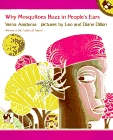
Aardema, Verna. Why Mosquitoes Buzz in People's Ears. Illustrated by Leo and Diane Dillon. Penguin USA, 1975. ISBN 0-8037-6087-6 Audiocassette from Weston Woods.
This African tale uses the cumulative format. A mosquito says something foolish to the iguana who puts sticks in his ears so that he will hear no more such foolishness, causing a chain of events.
Allen, Pamela. Who Sank the Boat? Putnam, 1990. ISBN 0-698-20679-7
¿Quién hundió el bote? SRA, 1995. Available in Big Book and Small Book formats.
A cow, a pig, a sheep, and a mouse enter a boat from biggest to smallest. Each passenger tips the boat and causes it to sit lower in the water. The question is repeated and answered after each animal gets into the boat. (See Picture Book Math, page 2.)
(Continued Below)
Advertisement:
Brett, Jan. Town Mouse, Country Mouse. Putnam, 1994. ISBN 0-399-22622-2
This rendition of the common folktale contrasts two lifestyles and the pattern is clear. (See page 8.)
Brown, Margaret Wise. Goodnight Moon. Illustrated by Clement Hurd. HarperCollins, 1947. ISBN 0-06-020706-X Audiocassette from Live Oak.
Buenas noches luna. Spanish from Lectorum.
This classic has been around so long that we tend to take it for granted, but the repetitive text that exactly fits the pictures makes it an ideal pattern book. Many of the children will already know the words.
Brown, Margaret Wise. The Important Book. Illustrated by Leonard Weisgard. HarperCollins, 1949. ISBN 0-06-020721-3
The pattern of attributes is the same throughout the book.
Brown, Ruth. A Dark Dark Tale. Penguin USA, 1981. ISBN 0-8037-0093-8 Audiocassette from Weston Woods.
This is a funny tale of a dark, dark night and a dark, dark visitor to a dark, dark house. Read it aloud in your spookiest voice - but whisper or squeak the ending.
Bulloch, Ivan. Patterns. Thomson, 1994. ISBN 1-56847-230-7
This book is one of a series called "Action Math" and presents activities for young children who are investigating patterns.
Butler, Stephen. The Mouse and the Apple. Morrow, 1994. ISBN 0-688-12811-4
A mouse is joined by other animals as he sits under a tree waiting for an apple to drop. The pattern of moving animals is obvious. (See Picture Book Math page 12.)
Carle, Eric. Rooster's Off to See the World. Picture Book Studios, 1991. ISBN 0-88708-042-1
The pattern of animals joining and leaving the procession is similar to that in many folktales.

Carle, Eric. The Tiny Seed. Picture Book Studio, 1991. ISBN 0-88708-015-4
It's fall and the seeds are being blown along by the wind. One tiny seed survives to flower and scatter its seeds to the wind. (See our Featured Book Teachers Guide online and also Picture Book Math, page 13.)
This delightfully simple book is as pleasant to touch as it is to view. The spider's web and the fly are raised from the page. This, combined with its repetitive text, should make it a favorite with the very young.
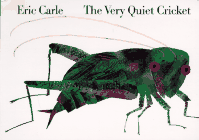
Carle, Eric. The Very Quiet Cricket. Putnam, 1990. ISBN 0 399-21885-8
As other insects pass him, making their unique sounds, a very small cricket tries again and again to chirp by rubbing his wings together. Each time a patterned sequence follows.
Carlstrom, Nancy. Jesse Bear, What Will You Wear? Illustrated by Bruce Degen. Simon and Schuster, 1986. ISBN 0-02-717350-X
This favorite is a rhyming text of repeated questions and phrases and is full of exuberant silliness.
(Continued Below)
Advertisement:
Cooney, Barbara. Miss Rumphius. Penguin USA, 1982. ISBN 0-670-47958-6 Audiocassette from Kimbo.
La Señorita Emilia. Spanish from Lectorum.
Patterning her life after her grandfather's, Miss Rumphius has three goals: to travel the world, to retire by the sea, and to leave the world more beautiful. (See Picture Book Math, page 16.)
de Regniers, Beatrice Schenk. So Many Cats! Illustrated by Ellen Weiss. Houghton, 1985. ISBN 0-89919-700-0
As each cat becomes part of the household, we recount the others. The repetitive text is charming. (See Picture Book Math, page 17.)
Emberley, Ed and Emberley, Barbara. Drummer Hoff. Simon and Schuster, 1985. ISBN 0-671-66682-7
Soldiers build a cannon and fire it, whereupon it explodes. Rhythmic text and rhyme with striking woodcuts tell the story.
Fox, Mem. Hattie and the Fox. Illustrated by Patricia Mullins. Simon and Schuster, 1988. ISBN 0-02-735470-9
This is a little bit like "The Little Red Hen" in that no one cares what a hen does or, in this case, what she sees. Each animal has a suitably disdainful reply to each observation she makes - until the fox springs out. These remarks form the basis for the predictable repetition.
Fox, Mem. Shoes from Grandpa. Illustrated by Patricia Mullins. Orchard, 1990. ISBN 0-531-08448-5
In this cumulative tale, each of Jessie's relatives buys her an article of clothing to go with the shoes her Grandpa bought her. Illustrated with cut-paper collage, the book is light and playful as Jessie's costume gets more and more elaborate. (See Picture Book Math, page 21.)
Guiberson, Brenda. Cactus Hotel. Illustrated by Megan Lloyd. Henry Holt, 1991. ISBN 0-8050-1333-4
We examine the ecology of a desert by observing the life cycle of a giant cactus. (See Picture Book Math, page 24.)
Heller, Ruth. Chickens Aren't the Only Ones. Putnam, 1981. ISBN 0-448-01872-1
Las gallinas no son las únicas. Spanish from Lectorum.
In this strikingly illustrated nonfiction book about egglayers, we see domestic birds, wild birds, insects, and dinosaurs. (See Picture Book Math, page 26.)
Henkes, Kevin. Chester's Way. Morrow, 1988. ISBN 0-688-07608-4
Chester, un tipo con personalidad. SRA, 1995. Available in Lap Book and Small Book formats.
Chester and Wilson are good friends and very much alike. The story pattern stresses their likenesses. (See Picture Book Math, page 27.)
Hoban, Tana. Dots, Spots, Speckles, and Stripes. Morrow, 1987. ISBN 0-688-06862-6
Vivid photographs wordlessly illustrate patterns in feathers, flowers, people, and animals.
Hoban, Tana. Exactly the Opposite. Morrow, 1990. ISBN 0-688-08862-7
As in other opposite books, the ABAB pattern is clear. From Hoban's typically vivid photographs we learn vocabulary as well as pattern.
Hoberman, Mary Ann. A House Is a House for Me. Illustrated by Betty Fraser. Penguin USA, 1978. ISBN 0-670-38016-4 Audiocassette from Live Oak.
A rhythmic text matches creatures with homes, starting out logically and getting a little zanier. The title is the repeated phrase. (See Picture Book Math, page 31.)
Hopkinson, Deborah. Sweet Clara and the Freedom Quilt. Illustrated by James Ransome. Random, 1993. ISBN 0-679-82311-5
A young slave stitches a quilt with a map pattern that will lead her to freedom.
Hutchins, Pat. Don't Forget the Bacon! Morrow, 1978. ISBN 0-688-06788-3 Audiocassette from Live Oak.
His mother sends him to the store for "Six farm eggs,/a cake for tea,/a pound of pears,/and don't forget the bacon." Chanting as he goes it becomes "Six clothes pegs,/a rake for leaves,/and a pile of chairs," but he forgets the bacon. Following his chant and making your own by changing the shopping list are pattern activities.
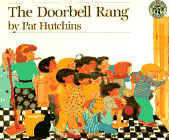
Hutchins, Pat. The Doorbell Rang. Morrow, 1986. ISBN 0-688-05252-5
Llaman a la puerta. Spanish from Lectorum.
The story doesn't tell us how many cookies there are at the beginning, but it does tell us how many there are for each child as more and more children arrive. The patterned text repeats throughout the book. (See Picture Book Math, page 33.)
Hutchins, Pat. Rosie's Walk. Simon and Schuster, 1968. ISBN 0-02-745850-4 Audiocassette from Weston Woods.
Rosie, the hen, takes a leisurely walk around the barnyard, not heeding the fox whom she foils at every turn. The words are easy to read because they are all prepositional phrases that detail Rosie's walk while completely ignoring the fox who is never mentioned in the text. The illustrations are full of unusual patterns, and predicting what will happen next to the fox brings students to the plot's pattern.
Jonas, Ann. Reflections. Morrow, 1987. ISBN 0-688-06141-9
We go through a day, looking at the illustrations from two directions. (See Picture Book Math, page 35.)
Kalan, Robert. Jump, Frog, Jump! Illustrated by Byron Barton. Morrow, 1981. ISBN 0-688-09241-1
¡Salta, ranita, salta! Spanish from Lectorum.
A cumulative tale that starts with a fly and ends with a frog nearly being caught by some boys. Each new event becomes part of the repeated pattern. (See Picture Book Math, page 36.)
Koscielniak, Bruce. Bear and Bunny Grow Tomatoes. Random, 1993. ISBN 0-679-93687-4
Bear and Bunny both start gardens. Bear is careful to do everything right - preparing the soil and tending the plants. Bunny throws the seeds on the ground and then sits back to watch. Bunny's antics as he waits for his tomatoes are silly and make this book wonderful in spite of the standard plot. The book emphasizes sequencing.
Lillegard, Dee. Sitting in My Box. Illustrated by Jon Agee. Penguin USA, 1989. ISBN 0-525-44528-5
A little boy starts out alone in his box. One by one other animals first join and then leave him. (See Picture Book Math, page 38.)
Lobel, Arnold. The Rose in My Garden. Illustrated by Anita Lobel. Morrow, 1984. ISBN 0-688-02587-0
Using their combined skills , Arnold and Anita Lobel tell of a simple incident in a garden. The words will stretch the imagination and the illustrations will delight the eye. Author Info.
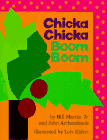
Martin, Bill Jr and Archambault, John. Chicka Chicka Boom Boom. Illustrated by Lois Ehlert. Simon & Schuster, 1989. ISBN 0-671-67949-X Big Book, Small Book, and audiocassette formats available from SRA.
Animated letters climb the tree in alphabetical order. The pattern is in the rhythmic chant and in the alphabetical order. (See Picture Book Math, page 41.)
McFarlane, Sheryl. Waiting for the Whales. Illustrated by Ron Lighburn. Putnam, 1993. ISBN 0-399-22515-3
A grandfather imparts his love of whale watching to his granddaughter as they wait for the yearly migration of the whales.
McMillan, Bruce. Becca Backward, Becca Frontward: A Book of Concept Pairs. Morrow, 1986. ISBN 0-688-06283-0
The ABAB pattern is clear in this book of colored photographs in which a dozen pairs of opposites are pointed out in the actions and reactions of a little girl.
McMillan, Bruce. Step by Step. Morrow, 1987. ISBN 0-688-07233-X
We watch a little boy moving around from the time he is four months until fourteen months old. He goes from wiggler to walker in color photographs.
Neitzel, Shirley. The Jacket I Wear in the Snow. Illustrated by Nancy Winslow Parker. Morrow, 1989. ISBN 0-688-08030-8
Using a "This Is the House That Jack Built" pattern, every piece of clothing is placed on the boy who can then do everything but walk. (See Picture Book Math, page 43.)
Numeroff, Laura Joffe. If You Give a Mouse a Cookie. HarperCollins, 1985. Illustrated by Felicia Bond. ISBN 0-06-024587-5
Each action causes another until we're back to the beginning cookie and mouse.
Ringgold, Faith. Tar Beach. Random, 1991. ISBN 0-517-58031-4
The pattern here is in the quilts. (See Picture Book Math, page 45.)
Sendak, Maurice. Chicken Soup with Rice. HarperCollins, 1962. ISBN 0-06-025535-8 Audiocassette from Weston Woods.
Sendak's ode to the seasons far precedes the current interest in pattern books, but it certainly fits the criteria.
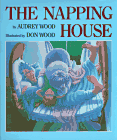
Shulevitz, Uri. One Monday Morning. Simon and Schuster, 1974. ISBN 0-684-13195-1
This is a delicate story of a lonely little boy and a chain of distinguished visitors. The story also emphasizes the days of the week.
Wood, Audrey. The Napping House. Illustrated by Don Wood. Harcourt, 1991. ISBN 0-15-256708-9 Audiocassette from Weston Woods.
This tale builds a pile of sleeping creatures and then puts a wakeful flea at the top. The humor, vocabulary, and color make this an outstanding book.

Additions Since Book Was Published
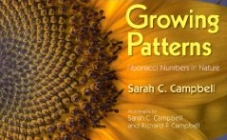
Growing Patterns: Fibonacci Numbers in Nature by Sarah C. Campbell. Illustrated by Sarah C. Campbell and Richard P. Campbell. (2010, Boyds Mill. ISBN 9781590787526. Order Info.) Nonfiction Picture Book. 32 pages. Gr 3-5.
Eye-catching close-up photographs show the Fibonacci sequence (1, 1, 2, 3, 5, 8, 13, 21, 34, 55 . . . ) in flower petals, pine cones, pineapples and seashells. The opening description is a bit confusing but is soon made clear. A great general exposure to patterns for the youngest students and a clear introduction to this crucial pattern for slightly older students.
![]()

Related Areas Within Carol Hurst's Children's Literature Web Site
- Math through Kids' Books. Featured Subject with links to more articles.
- The Tiny Seed by Eric Carle. Featured Book Teachers Guide with review, discussion ideas, activities, related books and links.
- The Very Quiet Cricket by Eric Carle. Teachers Guide with review, activities, related books and links.

